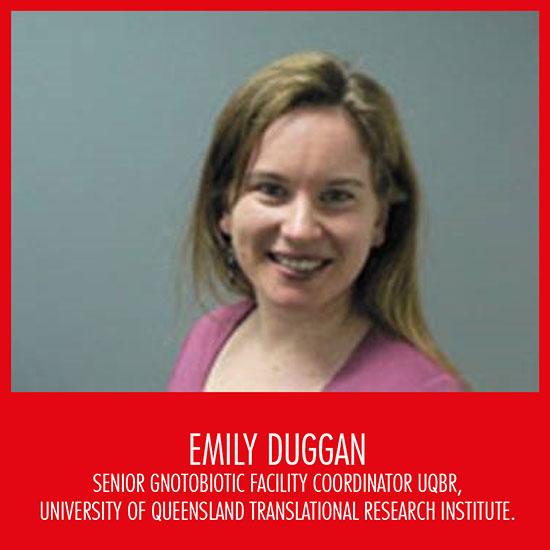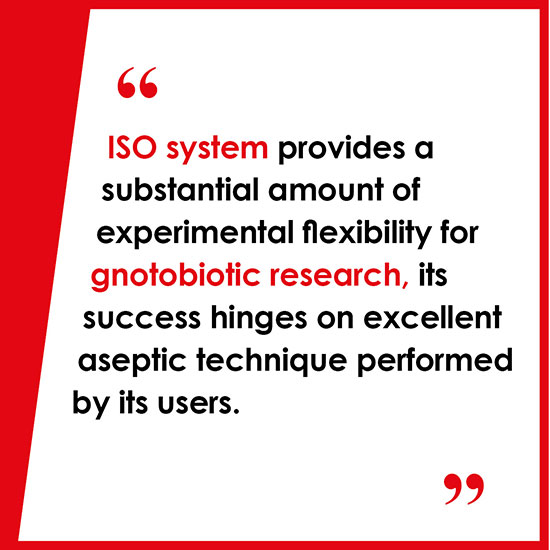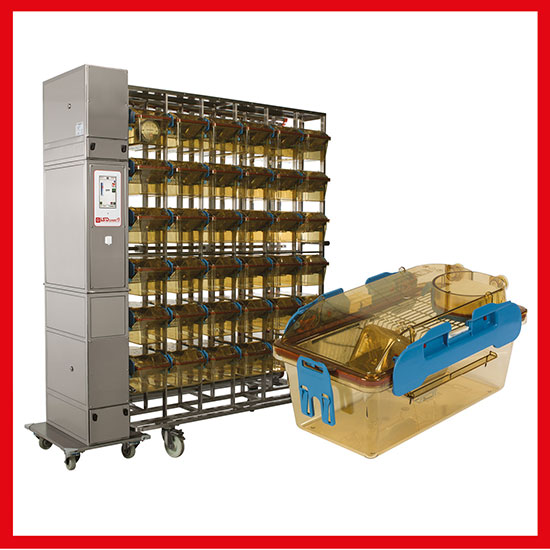
The current version of the Tecniplast website doesn't match your region. Please visit your local website to find information and offerings specific to your country.

The current version of the Tecniplast website doesn't match your region. Please visit your local website to find information and offerings specific to your country.

 “ISOCAGE” in three notions? Efficiency, flexibility and easy recycling of microbial status.
“ISOCAGE” in three notions? Efficiency, flexibility and easy recycling of microbial status.
Panorama has the pleasure and the honour to interview one of the most important Opinion Leaders of Gnotobiology in Australia, Emily Duggan, Senior Gnotobiotic Facility Coordinator UQBR, University of Queensland Translational Research Institute.
Dear Emily, we noted that Gnotobiotic topics are under the spotlight at The Animal Welfare Symposium, organized by SAHMRI and sponsored by Tecniplast Australia. Can you tell us the reasons?
Gnotobiotics is a fast growing field in Australia. Whilst it is not a new field and has been around for decades, in the past 3-4 years the number of facilities in Australia has grown from 1 in Melbourne, to 4 facilities across 4 states. Researchers are realising the huge impact that the microbiome has on health and disease and the need to have experimental models that can answer research questions in this area.
Can you tell our reader how Gnotobiotic trends are in Australia and which kind of challenges you are facing in Australia?
We are seeing an ever-increasing interest from our researchers in Australia in the area of Gnotobiotic research. We face challenges particularly in the area of expertise as there are very few Gnotobiotic animal technicians working in Australia (my last count included about 10-15 in total). Being geographically far from many other research communities and in a very different time zone we have had to figure out a lot of technical difficulties on our own.

Can you provide some insights into the complexities of Lab Animals and the microbiome? From your experience, what are the most difficult aspects and how do you solve these?
In addition to the realization of how much research is needed into the microbiota and its effect on the host, the research community is becoming increasingly aware of the effect that changes in the microbiome may have on experimental reproducibility. We know that the microbiota of our experimental models can be affected by many variables including type of bedding, feed, water sterilization methods, the facility the animals are housed in, shipping and many more variables.
We have already seen many cases where the phenotype of an experimental model shows a significant change after moving from one animal facility to another, sometimes having a detrimental effect on the research study. One way we are looking to combat this problem is to enable researchers to cryopreserve the microbiome of their experimental model via freezing gut and faecal contents. This paired with the ability to rederive animal models to a germ-free status will allow us to reconstitute the model at a later date if there has been a significant shift in the microbiome.
We know you have extensively applied the use of ISOcaging to Gnotobiotic work. Can you list the 3 most important reasons and benefits of using the ISO System for our readers?

1. Efficiency of space
Traditional Gnotobiotic studies have been performed using flexible film “Trexler-style” isolators. Animals within these isolators are housed in open-topped cages. This means that whatever the gnotobiotic status within the isolator will be the same for all cages within that isolator. As such, researchers wanting to perform experiments with multiple different microbiota samples would require a separate isolator for each microbiota sample - that’s a lot of floor space for one experiment! The ISOcage system has cages with individual cage level HEPA filters that allow researchers to have different flora groups right next to each other on the same rack. One rack can easily accommodate 35 different sample groups.
2. Flexibility with experimental options
The ISOcage systems requires the use of a sterile biosafety cabinet for all handling and procedures with experimental mice in order to maintain their gnotobiotic status free of contamination. The cage exterior is cold sterilized before entry into the biosafety cabinet along with all other supplies and PPE being sterile. By allowing researchers a true “hands-on” experience within a biosafety cabinet this can make more complicated procedures (eg injections, surgery) much easier than if performed via large isolator gloves that limit dexterity.
3. Easy recycling of microbial status
At the conclusion of a gnotobiotic experiment, a gnotobiotic isolator requires resterilization to return it to a germ-free status. For flexible film isolators this is an expensive, time-consuming and labour intensive process taking up to 6 weeks, particularly where an experiment involves multiple microbiotas, and so multiple isolators to sterile. ISOcages enable a quick clean and resterilization process allowing a freshly sterile cage ready the next day. There is also much less risk to the entire experiment if contamination happens (and it will from time to time!). With an ISOcage you risk only one cage of mice at a time, whereby a break in an isolator can result in the loss of many cages at once.
From your experience, do you think that training on performing Gnotobiotic procedures and the use of the ISO system is important, especially for new users?
Training is by far one of the most crucial steps in using the ISO system. Whilst the ISO system provides a substantial amount of experimental flexibility for gnotobiotic research, its success hinges on excellent aseptic technique performed by its users. As is often said in Gnotobiotics “there is no 5 second rule”! Technicians at the TRI Gnotobiotic facility are trained in how to prepare cages prior to sterilization, right through to how to move around the cages within a biosafety cabinet without risking contaminating the inside of the ISO cage.
How important is it to stay connected with the international Gnotobiotic community?
It’s absolutely vital to engage with the international Gnotobiotic community. The very nature of this work requires a high level of problem solving to convert “regular” animal model experiments into “Gnotobiotic” experiments whereby we can prevent contamination of our animals.
There are a number of resources available to Gnotobiotic facilities and researchers internationally which are incredibly valuable. The Gnotobiotics ListServ email group, run by the University of Alabama Birmingham, is a very useful tool for sharing knowledge and protocols. Also, the Association for Gnotobiotics provides up to date publications and conference information to keep us all in the loop.
VESNA VALIC
MANAGING DIRECTOR -TECNIPLAST AUSTRALIA